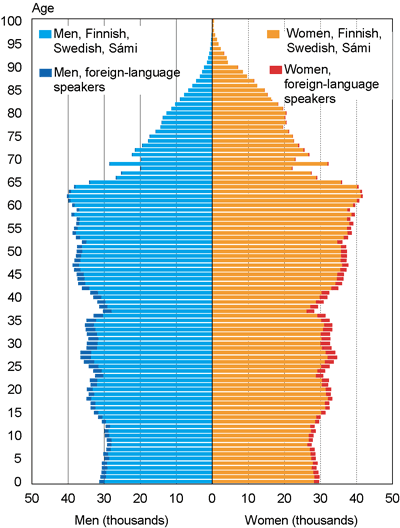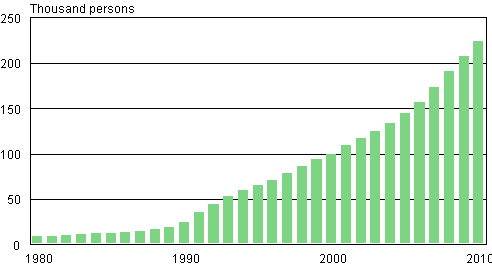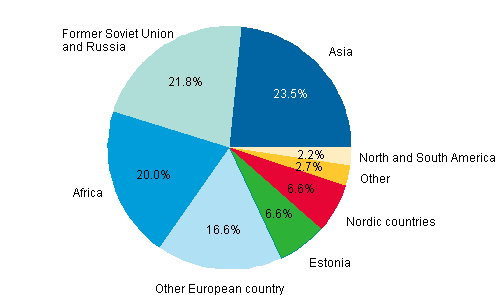Foreign-language speakers are still rare in many municipalities
Author: Markus Rapo
In Finland, a foreign-language speaker is defined as a person who speaks a language other than Finnish, Swedish or Sámi as his or her native language. In 1980, there were some 9,000 foreign-language speakers in Finland, and while their number has increased more than 25-fold over three decades, they are still rare in many Finnish municipalities.
Population by age, sex and native language in 2010

When looking at the number of foreigners, the definition may be based on either nationality, country of birth or native language. Using the nationality presents a problem, as a person may be granted Finnish citizenship while living in Finland, after which he or she no longer is a foreign citizen in the statistics. When relying on the country of birth, on the other hand, we must not overlook the fact that children may be born to a Finnish family during a stay abroad. Consequently, by far the best variable for examining the number of foreigners is the native language.
Number of foreign-language speakers highest in Uusimaa, lowest in South Ostrobothnia
At the end of the year 2010, there were some 224,000 foreign-language speakers living in Finland. Especially in the 2000s, the number of foreign-language speakers has increased dramatically. In 1993, this figure totalled more than 50,000, and it exceeded 100,000 in 2001 and 200,000 in 2009. The number of foreign-language speakers has been boosted by immigration not only from Russia and Estonia but also from Asia.
Number of foreign-language speakers in Finland in 1980-2010

Foreign-language speakers in Finland mostly live in Southern Finland, near the eastern border and on the west coast. More than one-half of our foreign-language population live in the region of Uusimaa. In a proportional analysis, too, the share of foreign-language speakers is the highest in Uusimaa, or 8 per cent of the population in the area. This figure is the lowest in South Ostrobothnia, where the share of foreign-language speakers is one per cent of the population only.
There are also variations in the way different groups of foreign-language speakers are concentrated in Southern Finland. Uusimaa is home to 77 per cent of all Somali speakers and 62 per cent of all Estonian speakers in Finland. Of Russian speakers, 46 per cent and of Thai speakers 42 per cent live in Uusimaa.
Foreign-language speakers more concentrated than others
The Finnish population is concentrated in large urban centres. Almost a quarter of our population live in the four municipalities with the largest population, or Helsinki, Espoo, Tampere and Vantaa. The groups speaking a foreign language as their native language show an even stronger concentration. One-half of the foreign-language speaking population in our country live in these four municipalities. In total, 75 per cent of foreign-language speakers in Finland live in the area of 17 municipalities only.
Helsinki has the largest population of foreign-language speakers, both in absolute numbers and proportionally. At the end of 2010, there were more than 63,000 foreign-language speakers living in Helsinki, which is 11 per cent of the city's population. If the foreign-language speakers living in Helsinki had a municipality to themselves, its population would be the 15th largest in Finland.
However, foreign-language speakers are still rare in many Finnish municipalities. In one municipality out of three, less than one per cent of the population are foreign-language speakers. The adjacent map animation describes the trend in the share of foreign-language population in municipalities in 1980-2010.
Russian or Estonian speakers are the most numerous
The largest group of foreign-language speakers by far is Russian speakers. At the end of 2010, they totalled some 55,000 in Finland; in other words, one foreign-language speaker out of four speaks Russian as his or her native language. The second largest group of 28,000 is Estonian speakers. The speakers of Somali and English both total some 13,000. The next largest group is Arabic speakers with a total of 10,000.
Examined by region, Russian speakers are the largest group of foreign-language speakers in all other regions except those of Kanta-Häme and Åland, where the largest groups are Estonian and Latvian speakers.
Largest groups of foreign-language speakers by region in 2010
| Foreign-language speakers in total |
Largest group | Second largest group |
Third largest group |
|
| Province: | ||||
| Whole country | 224,388 | Russian | Estonian | Somali |
| Uusimaa | 122,102 | Russian | Estonian | Somali |
| Varsinais-Suomi | 20,606 | Russian | Estonian | Albanian |
| Pirkanmaa | 15,580 | Russian | Estonian | Arabic |
| Ostrobothnia | 7,100 | Russian | Somali | Bosnian/ Vietnamese |
| Kymenlaakso | 7,093 | Russian | Estonian | Somali |
| North Ostrobothnia | 6,492 | Russian | English | Estonian |
| Päijät-Häme | 6,488 | Russian | Estonian | Kurdish |
| Central Finland | 5,743 | Russian | Estonian | English |
| South Karelia | 4,899 | Russian | Estonian | English |
| Pohjois-Savo | 4,073 | Russian | Estonian | Arabic |
| North Karelia | 3,953 | Russian | Somali | Estonian |
| Kanta-Häme | 3,805 | Estonian | Russian | Vietnamese |
| Satakunta | 3,656 | Russian | Estonian | Polish |
| Lapland | 3,167 | Russian | German | English |
| Etelä-Savo | 3,053 | Russian | Estonian | Arabic |
| South Ostrobothnia | 2,332 | Russian | Estonian | Hungarian |
| Kainuu | 1,630 | Russian | Somali | Kurdish |
| Åland | 1,462 | Latvian | Romanian | Estonian |
| Central Ostrobothnia | 1,154 | Russian | Estonian | Arabic |
Either alone or with some other equally large group, native speakers of Russian make up the largest group of foreign-language speakers in a total of 177 municipalities. In a similar analysis, Estonian speakers are the largest group in 117 municipalities. In a few municipalities, the largest group of foreign-language speakers comprises the speakers of some other language, such as English (nine municipalities), Thai (seven) or Latvian (six).
Some 440,000 Finns or people with a Finnish background live in Sweden
The number of foreigners in Finland is relatively low. As few countries keep statistics on the native languages of their population, international comparisons may only be made based on nationality or country of birth. At the end of 2009, Finland had the seventh lowest number of foreign citizens living in the country among all EU Member States.
At the end of 2010, the number of persons in Finland having been born abroad was 248,000, or 4.6 per cent of the population. However, 43,000 of those born abroad speak Finnish as their native language.
In Sweden, similarly, the number of persons having been born abroad at the end of 2010 was 1,385,000 – 14.7 percent of the population – or in proportion, three times as many as in Finland. There were 170,000 people living in Sweden who had been born in Finland. The majority of them emigrated to Sweden in the late 1960s and early 1970s.
As the immigration proper of foreigners to Finland actually only began in the 2000s, the number of so-called second-generation immigrants, or persons with a foreign background, in Finland is low. At the end of 2010, there were 37,000 people living in Finland who were born in Finland and whose both parents (or the only known parent) had been born abroad. One-half of them are under school age. The diagram below illustrates the countries of birth of these second-generation immigrants' parents, mainly those of the mothers.
Persons with a foreign background* born in Finland, parents' country of birth in 2010

*) The person him/herself born in Finland and both parents (or the only known parent) born abroad
As a slight surprise perhaps, the largest group of second-generation immigrants in Finland is those with an Asian background, or nearly 24 per cent. The share of those with a background in the former Soviet Union (and Russia) is some 22 per cent. The third largest group is people with an African background, 20 per cent. Those with a background in the Nordic countries, Estonia or other European countries account for a total of some 30 per cent.
As a comparison, we can note that at the end of 2009, there were 64,000 people with a Finnish background living in Sweden. They are children born in Sweden to parents who were both born in Finland. At that time, there were a total of 440,000 people living in Sweden who were either born in Finland, were Finnish citizens or had at least one parent who had been born in Finland.
- Release of Statistics Sweden (SCB) (in Swedish)
The author, Markus Rapo, is Senior Statistician at the Population Statistics department of Statistics Finland.
Last updated 11.7.2011
